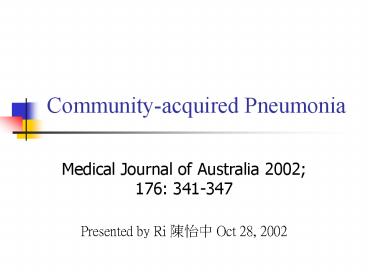Community-acquired Pneumonia - PowerPoint PPT Presentation
1 / 28
Title:
Community-acquired Pneumonia
Description:
Community-acquired Pneumonia. Medical Journal of Australia 2002; 176: 341-347 ... Legionnaire's disease, TB and psittacosis: notifiable disease. Conclusion ... – PowerPoint PPT presentation
Number of Views:367
Avg rating:3.0/5.0
Title: Community-acquired Pneumonia
1
Community-acquired Pneumonia
- Medical Journal of Australia 2002 176 341-347
- Presented by Ri ??? Oct 28, 2002
2
Introduction
- Possible pathogens
- Antibiotics choosing
- Antibiotics resistance
- Be treated at home or hospital?
3
Epidemiology
- In US, mortality averages 14 in 2000.
- Less than 1 for those outpatients
4
Risk Factors
5
Causative Organisms
- Most common S. pneumoniae
- H. influenzae
- S. aureus
- Enteric gram-negative bacteria
- Mycoplasma pneumoniae
- Chlamydia
- Legionella
- Mycobacterium tuberculosis
- Others (Pseudomonas, virus)
6
Aspiration Pneumonia
- An variant of CAP
- Elderly people, bulbar weakness, laryngectomy or
stroke - S. aureus, H. influenzae, and G (-) aerobes
- No anaerobes? Chest 1999 115 178-183.
7
Diagnosis
- Two or more
- Fever
- Rigors
- New-onset cough
- Change in sputum color if chronic cough
- Chest discomfort
- Dyspnea
8
Investigation
- CXR
- Clearly show consolidation
- Poor guide to the likely pathogen
- D/D from other cause
- Initially appears normal?
- Sputum smear culture
- Try to identify pathogens
9
Investigation
- CBC, BCS and ABG
- Blood culture
- Most specific diagnostic test
- Others
- Legionella urinary antigen test
- Viral immunofluorescence testing
- Serological diagnosis
- PCR
10
Management
- What is the severity?
- Where should the patient be managed?
- Which antibiotics should be used?
11
Risk stratification
12
Pneumonia Severity Index
13
(No Transcript)
14
Mortality
15
(No Transcript)
16
(No Transcript)
17
Antibiotics Choice
- Resistance
- Streptococcus
- H. influenzae
- Mycoplasma, Chlamydia and Legionella
18
Incidence of Drug-resistant Pneumococcus (DRSP)
in CAP
- Cefotaxime 42
- Meropenem 52
- Erythromycin 61
- Trimethoprim/sulfamethoxizole 92
- Quinolone (ciprofloxacin) 2.9
- Whitney CG, Increasing prevalence of
multi-drug resistant Streptococcus pneumonia in
the United States N Engl J Med 2000
3431917-1924
19
Low-risk patients
- Risk class?and many patients in classes?and ?
(PSI lt 90) - Oral antibiotics in the community
- Amoxicillin roxithromycin or doxycycline
- Allergy or resistance?
- Oral cefuroxime or iv Rocephin with roxithromycin
or doxycycline po
20
Higher-risk patients
- PSI risk class?
- Require IV therapy
- Benzylpenicillin IV roxithromycin or
doxycycline po - S. aureus and G (-) rods
- flucloxacillin or dicloxacillin
- aminoglycoside or extended-spectrum
cephalosporin
21
Highest-risk patients
- PSI risk class?
- Early broad-spectrum parenteral therapy
- IV erythromycin Rocephin or Claforan
- IV erythromycin penicillin gentamicin
22
Role of Fluoroquinolone
- Reserved for
- Treatment failure
- Allergy to other agents
- DRSP
- Avoid widespread using
23
Supportive Care
- Hypoxaemia - continuous O2 therapy
- Asthma or COPD bronchodilator
- Adequate hydration, but avoid overload
- ARF temporary dialysis
- Pain control
24
Follow-up
- Improvement on CXR is often slow
- Most patients recovery in 24 to 72 hrs
- Failure to improve ? review of the case
- Abx failure is not usually the reason
25
Treatment Failure
- Is the diagnosis correct?
- Is the patient taking the Abx?
- Need admission IV therapy?
- Any complication?
- Any obstruction?
- Abx resistance?
- TB? HIV?
- Advanced investigation
26
Prevention and Public Health
- Risk factors age gt 65
- Influenza vaccination annually
- Pneumococcal vaccination five-yearly
- Legionnaires disease, TB and psittacosis
notifiable disease
27
Conclusion
- CAP is caused by a range of organisms, most
commonly S. pneumoniae - CXR is required for diagnosis
- A risk score can aid Tx decisions
- Antibiotics should be given according to specific
pathogen
28
- Thanks for Your Attention !































